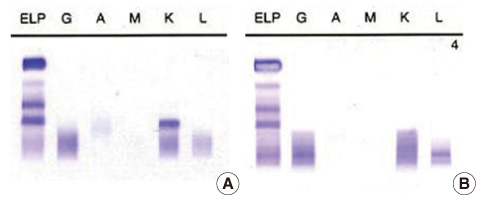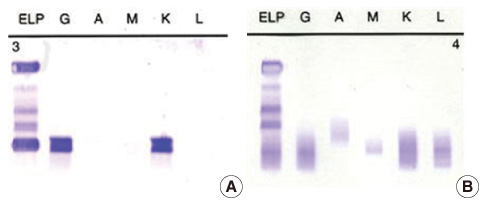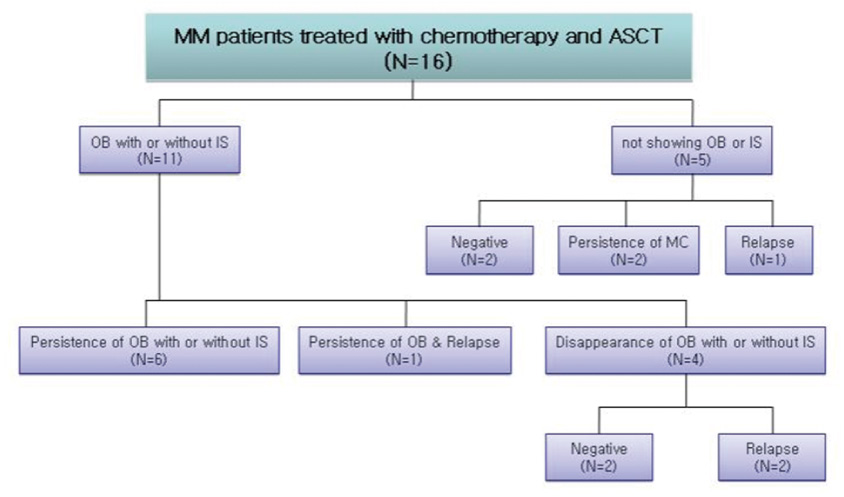Lab Med Online.
2012 Jan;2(1):28-33. 10.3343/lmo.2012.2.1.5.
Clinical Significance of Oligoclonal Bands in Patients with Multiple Myeloma after Autologous Stem Cell Transplantation
- Affiliations
-
- 1Department of Laboratory Medicine, Korea Cancer Center Hospital, Korea Institute of Radiological & Medical Sciences, Seoul, Korea. cyhlabo@kcch.re.kr
- 2Department of Internal Medicine, Korea Cancer Center Hospital, Korea Institute of Radiological & Medical Sciences, Seoul, Korea.
- 3University of Science & Technology, Daejeon, Korea.
- KMID: 1435749
- DOI: http://doi.org/10.3343/lmo.2012.2.1.5
Abstract
- BACKGROUND
Oligoclonal bands or isotype switch detectable by serum immunofixation electrophoresis (IFE) has been reported following chemotherapy and stem cell transplantation in patients with multiple myeloma (MM). We studied the significance of oligoclonal bands appearing after chemotherapy and autologous stem cell transplantation (ASCT) in Korean MM patients, and its impact on relapse. And we investigated the serial serum free light chain (FLC) ratio to establish its possible relationship with the relapse of MM.
METHODS
We conducted a retrospective analysis of the serial serum IFE and FLC ratio in 16 MM patients treated with chemotherapy and ASCT.
RESULTS
Eleven out of 16 patients (68.8%) had oligoclonal bands with or without isotype switch after ASCT and the median interval from transplantation was 2.0 months. And relapse or persistence rate of monoclonal gammopathy was lower in patients with oligoclonal bands (27.3% vs. 60.0%), though without statistical significance (P=0.299). In eight patients who developed oligoclonal bands and did not relapse, the serial serum FLC ratio was normal in range. But one patient who developed oligoclonal bands and showed increase of plasma cells in bone marrow, the serial serum FLC ratio was abnormal in range.
CONCLUSIONS
The occurrence of oligoclonal bands after chemotherapy and ASCT in Korean MM patients is not significantly associated with adverse consequence of relapse or persistence of monoclonal gammopathy. Therefore oligoclonal bands may be not bad prognostic criterion. And the measurement of serum FLC ratio may be a useful indicator to predict relapse in MM patients who developed oligoclonal bands.
MeSH Terms
Figure
Reference
-
1. Zent CS, Wilson CS, Tricot G, Jaqannath S, Sieqel D, Desikan KR, et al. Oligoclonal protein bands and Ig isotype switching in multiple myeloma treated with high-dose therapy and hematopoietic cell transplantation. Blood. 1998. 91:3518–3523.
Article2. de Larrea CF, Cibeira MT, Elena M, Arostequi JI, Rosiñol L, Rovira M, et al. Abnormal serum free light chain ratio in patients with multiple myeloma in complete remission has strong association with the presence of oligoclonal bands: implications for stringent complete remission definition. Blood. 2009. 114:4954–4956.
Article3. Maisnar V, Tichý M, Smolej L, Zák P, Radocha J, Palicka V, et al. Isotype class switching after transplantation in multiple myeloma. Neoplasma. 2007. 54:225–228.4. Hall SL, Tate J, Gill D, Mollee P. Significance of abnormal protein bands in patients with multiple myeloma following autologous stem cell transplantation. Clin Biochem Rev. 2009. 30:113–118.5. Alejandre ME, Madalena LB, Pavlovsky MA, Facio ML, Corrado C, Milone G, et al. Oligoclonal bands and immunoglobulin isotype switch during monitoring of patients with multiple myeloma and autologous hematopoietic cell transplantation: a 16-year experience. Clin Chem Lab Med. 2010. 48:727–731.
Article6. Sucak G, Suyani E, Özkurt ZN, Yeğin ZA, Aki Z, Yaqci M. Abnormal protein bands in patients with multiple myeloma after haematopoietic stem cell transplantation: does it have a prognostic significance? Hematol Oncol. 2010. 28:180–184.
Article7. Hovenga S, de Wolf JT, Guikema JE, Klip H, Smit JW, Smit Sibinga CT, et al. Autologous stem cell transplantation in multiple myeloma after VAD and EDAP courses: a high incidence of oligoclonal serum Igs post transplantation. Bone Marrow Transplant. 2000. 25:723–728.
Article8. Mitus AJ, Stein R, Rappeport JM, Antin JH, Weinstein HJ, Alper CA, et al. Monoclonal and oligoclonal gammopathy after bone marrow transplantation. Blood. 1989. 74:2764–2768.
Article9. Hammarström L, Smith CI. Frequent occurrence of monoclonal gammopathies with an imbalanced light-chain ratio following bone marrow transplantation. Transplantation. 1987. 43:447–449.
Article10. Butch AW, Badros A, Desikan KR, Munshi NC. Expression of a free gamma heavy chain in serum following autologous stem cell transplantation for IgG kappa multiple myeloma. Bone Marrow Transplant. 2001. 27:663–666.
Article11. Durie BG, Harousseau JL, Miguel JS, Bladé J, Barloqie B, Anderson K, et al. International uniform response criteria for multiple myeloma. Leukemia. 2006. 20:1467–1473.
Article
- Full Text Links
- Actions
-
Cited
- CITED
-
- Close
- Share
- Similar articles
-
- Detection of oligoclonal bands in the cerebrospinal fluid(CSF) using the Phast@-polyacrylamide gel electrophoresis(PAGE) system
- Emergence of chronic myeloid leukemia following autologous stem cell transplantation in a young woman with multiple myeloma
- A Case of Cerebral Toxoplasmosis Following Tandem Autologous Stem Cell Transplantation in a Multiple Myeloma Patient
- HBV reactivation in a HBsAg-negative patient with multiple myeloma treated with prednisolone maintenance therapy after autologous HSCT
- Successful Chemotherapy Following Autologous Stem Cell Transplantation in Multiple Myeloma and Multi-organ Dysfunction with Infiltration of Eosinophils: A Case Report




